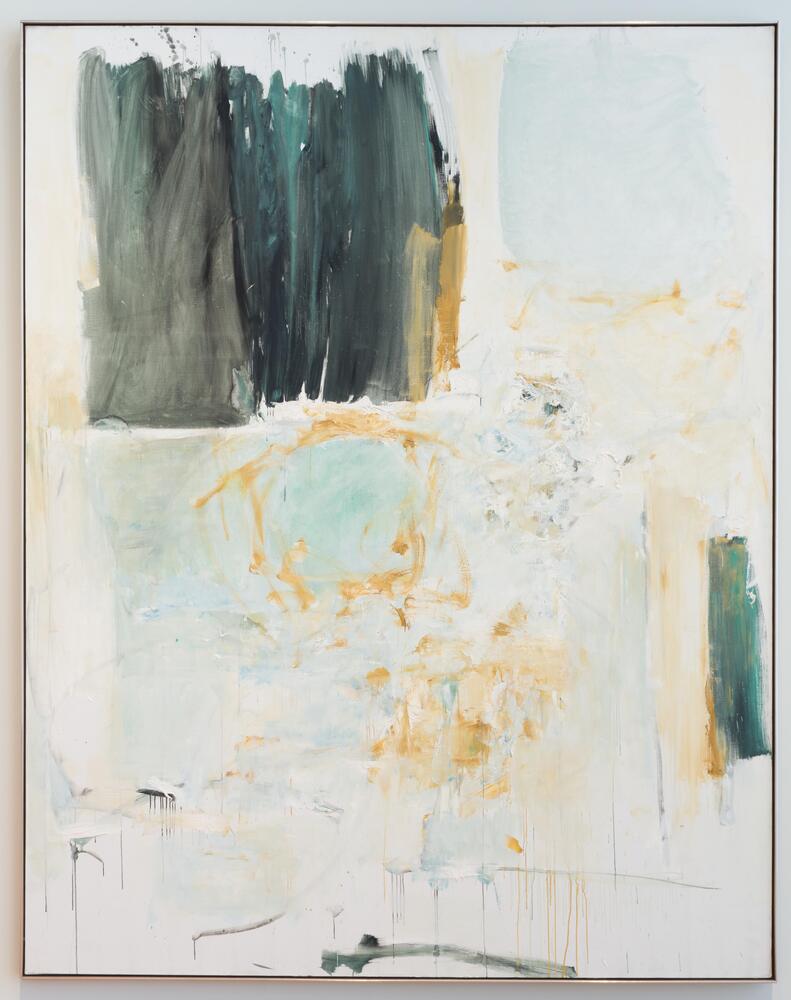First Grade: Spring Into Art! Weather, Seasons, and Art
Docent Curricular Tour
Discussion: Artists record the actual weather and seasons in art but also use weather as a metaphor for other things such as emotions, obstacles to progress, stages of life and even stages of empire. During this tour students should be able to practice their scientific knowledge as they recognize, describe and propose ways to measure weather as well as begin to understand mood and the way artists communicate personal experiences metaphorically or symbolically.
Science Concept: Meteorologists—people who study weather—use symbols and descriptive terms to communicate about weather. NOTE: there are definitions of cloud and wind types at the end of this document.
Art Concept: Describe the mood or feeling a specific artwork evokes. Share personal impressions about art experiences
Stop 1: Huntington, In the Mountain Fastness
Weather concept: types of clouds; Art concept: weather can be a metaphor for mood.
Engagement Strategies: How would your skin feel if you were in this painting or in a place with this weather? Do you think you would have goosebumps? What kind of clothing would you want to be wearing? How do your feelings or emotions feel when you look at this? Do you know the expression “feeling blue”? Or feeling like you “have a dark cloud hanging over you”?
Talking points:
Sometimes artists use weather conditions to reflect their feelings or their difficulties in life. Maybe they are thinking about a time when they had something really hard to do or they were very worried.
It is hard to show all the thoughts in your head but sometimes you can use weather to indicate what you are feeling.
Note the colors and line, shapes and roughness (compare sunset corner).
Note the clouds! What kind of clouds are they?
What kind of clouds would you paint if you wanted to show that you were feeling happy?
What kind of clouds would you paint if you wanted to show that you were feeling quiet?
Alternative: Magnasco, Landscape with Washerwomen
Stop 2: Monet
Weather concept: meteorologists study weather; art concept: Impressionists capture the specific weather and light conditions at specific times.
Props: on the iPads: view of frozen lakes and rivers
This is Susan Clinthorne’s Monet Weather Report stop—be sure to check the weather for the day before you do this tour so you can insert the appropriate weather report. "I bet the first thing everybody did today was check the weather. Well if you missed it- this is the weather forecast for Ann Arbor, Michigan. [Fill in prediction for the day you are having such as: We will have a high of 20 degrees. It will be cloudy with a chance of snow showers throughout the day. The chance of snow is 70%. Winds are from the northwest at 20 MPH. ]
The weather for Paris, France today [get today’s weather]: A high of 46 and a low of 37. It will be partly sunny. Wind is 4 mph. And there is no chance of rain or snow. Do you think we could make a weather forecast for a day that happened 127 years ago? [see art concept above… one of the interesting features of Impressionist paintings is that they tried to capture a scene as it looked and felt on that day.]
Well, lets continue our talk about the weather while we look at this painting by Claude Monet called The Break up of the Ice. It is a painting of the River Seine near Paris, France. It was painted in 1880, probably in February. Let’s be time detectives and make up a weather forecast for this day.
What's going on here? Is a river usually so wide? It might go over the banks! What kind of things could we say about the temp? Cold. How cold? Why do you say that? We see snow, ice. Any other clues? What about color? What kind of colors did he use to make us sense the cold? How did he show us that there is ice in the river? (color, impasto-thick, textured paint) What about the trees? How does he show that they are winter trees? What about the sky? Can you tell where the sun is? How? Do you think it’s as cold as today? Yes or no. So, maybe in the 30s or 40s. It could be a little warmer than today because the river isn’t frozen solid- after a thaw. How about the cloud cover? Could we say sunny, partly sunny, cloudy? Do you think there might be snow on this day? Why? All day?
Is it a calm day or a blustery day? What tells you that? Maybe sky, movement of the ice, trees. Let’s talk about the way the artist used lines. In general, when an artist uses horizontal lines, they want us to feel calm. But if the artist uses diagonals, it creates a feeling of energy. We can see the ice is arranged in diagonals. Also, what about the way the paint is applied? How would you describe the brush strokes? (fast, choppy) Do you feel energy from the style? So, a little breeze? Maybe like today in Ann Arbor?
So the weather forecast for this day in Paris, France in 1880 might go like this: Cold today. Hi around 35 degrees. It is cloudy with a 100% chance of snow showers throughout the day. The wind is about 4 mph. Possibility of flooding along the river. There may be some clearing later in the day. Mr Monet was a called an Impressionist painter. This means that he did not try to make his painting look like a photograph. But he tried to capture light, energy, feelings and weather conditions in his paintings. He was also a pleine air painter. That means he did most of his paintings outside. At this time in his life he was having a sad time because his wife had died. And it was so cold out that he had to do most of his painting in his studio. He heard that the river was thawing and flooding and the ice had started to break apart. He went to see it and was so excited that he went out and painted and painted. He did around 23 paintings of the River Seine in this particular winter.
Do you think the painting might reflect his inner feelings? Why. Does the energy in the brush strokes relate to his excitement about the ice?
Alternative: Dow, Spring
Stop 3: Joan Mitchell
Weather concept: white = very hot or very cold weather; Art concept “internal weather” may refer to your imagination or memories of how weather or a place made you feel.
Engagement Strategies: BEFORE YOU ARRIVE AT THE PAINTING ask “When I say “White Territory” what do you imagine? Where would a place called white territory be in the world? Siberia? The desert? Your backyard in the winter or on a really sunny day? What kind of weather would be white?
Talking points:
· Sometimes artists use color and weather to indicate a mood. Joan Mitchell said that she paints “internal weather.” What do you think that means? Do you have weather inside you? [hahaha] No! How about inside your imagination? What you see here is a reflection of how Mitchell felt inside.
· There is lots of white here. What weather do you think she was remembering and how do you think she felt when she painted this?
· Imagine a white territory … where would it be in the world? Discuss white weather—different kinds such as arctic and Saharan. Extreme places where there is little growing. Use thermometer to discuss how hot is hot and how cold is really cold.
Stop 4: Frankenthaler, Sunset Corner
Weather concept: what makes sunsets red; art concept: artists use their materials in special ways for special effects (unprimed canvas creates soft, atmospheric edges
Engagement Strategies: BEFORE YOU GET TO THE PAINTING say to the children “close your eyes and imagine a dramatic sunset you remember from your life. What did it look like and how did it make you feel?” [try to elicit good, big bright AND dramatic, scary, responses]
Talking Points:
· How is this painting, called “Sunset Corner,” similar to or different from the one in your memory? Discuss.
· The sky at sunset looks different than at noon [see below]. Why is that?
· Why would an artist choose to use sunsets to express feelings?
· Helen Frankenthaler made the colors in this painting soft and blended by pouring paint right onto the canvas. This is more sunset-like than painting precise edge.
Info on Sunsets: Long story short, the answer to ‘why is the sunset red?’ is … At sunset, light must travel farther through the atmosphere before it gets to you, so more of it is reflected and scattered and the sun appears dimmer. The color of the sun itself appears to change, first to orange and then to red because even more of the short wavelength blues and greens are now scattered and only the longer wavelengths (reds, oranges) are left to be seen. We have written many articles about the sunset for Universe Today. Here’s an article about sunrise and sunset. If you’d like more info on the Sun, check out NASA’s Solar System Exploration Guide on the Sun.
Stop 5: Japanese Gallery Blue and white plate
Weather concept: fog; Art concept: although fog is full of water vapor it looks and feels empty and kind of lonesome
Engagement Strategies: Do you have any dishes with pictures on them? What kind of pictures?
Talking points:
· This artist has painted a very beautiful landscape on a plate. Look how much empty space there is? What do you think the artist meant for us to understand about the weather that he or she did not picture?
· What kind of day do you think this is? The empty area seems to be water, such as a river. Weather is sometimes different over water (discuss the water, lake effect snow, tornadoes vs hurricanes…)
· Here the artist has left the water and the weather up to our imagination. How do you feel when you look at this plate? Calm? Maybe the artist wanted us to guess the weather based on how we feel when we look at this quiet scene.
Docent comments: This plate is kind of small to use with children. Maybe use a hanging scroll instead.
Fog
The fog comes
on little cat feet.
It sits looking
over harbor and city
on silent haunches
and then moves on.
-Carl Sandburg
Possible Props:
A laminated copy of a thermometer (Fahrenheit and Celsius) will be available. Use to help children understand what 30° means as opposed to 80°.
Other
possible props: rain gauge; windsock; barometer; pictures of clouds (http://www.weatherwizkids.com/weather-clouds.htm or other sources)
Part of 1 Learning Collection
<p>Docent Curricular Tour</p>
Rate this Resource
AVG: 0 | Ratings: 0
& Author Notes
Creative Commons by-nc-saLast Updated
April 25, 2017 10:42 a.m.Report
Reporting Policy






